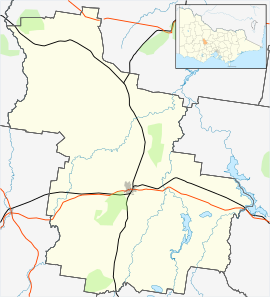Town in Victoria, Australia
| Moliagul Victoria | |
|---|---|
 Miners and their wives posing with the finders of the largest alluvial gold find in the world, the Welcome Stranger. Miners and their wives posing with the finders of the largest alluvial gold find in the world, the Welcome Stranger. | |
 | |
| Coordinates | 36°45′03″S 143°39′47″E / 36.75083°S 143.66306°E / -36.75083; 143.66306 |
| Population | 80 (2021 census) |
| Postcode(s) | 3472 |
| Location | |
| LGA(s) | |
| State electorate(s) | Bendigo West |
| Federal division(s) | Mallee |
Moliagul is a locality in the Shire of Central Goldfields and Shire of Loddon, Victoria, Australia, located 202 kilometres (126 mi) northwest of Melbourne and 60 kilometres (37 mi) west of Bendigo. The area is notable for the discovery of a number of gold nuggets. These finds include the world's largest, the Welcome Stranger, which was discovered in 1869 by John Deason and Richard Oates. At the 2021 census, Moliagul had a population of 80.
Moliagul is composed of scattered rural dwellings and small farms, a hotel (now closed), museum, the old school (now a hall) and former church.
Mount Moliagul is located in the locality.
History
The name Moliagul is believed to be a derivation of the Aboriginal word "moliagulk", meaning "wooded hill". In late 1852, gold was discovered in Queen's Gully and the settlement of Moliagul sprang up almost immediately. By January of the next year a thriving goldfields town with a store, a butcher's shop and a blacksmith's forge had opened but almost immediately the new settlement was abandoned as people departed for the Sandy Creek gold rush.
In July 1855, gold was found at Little Hill and a second gold rush occurred in the Moliagul area. In 1855 it is estimated there were 16,000 people living in the immediate area during the peak of the Victorian gold rush period. In 1856 the Mount Moliagul Hotel was opened. Moliagul Post Office opened on 15 November 1858 and closed in 1971. The Moliagul Cemetery contains the headstones of many families, such as the Deason's, which date back to the gold rush times.
Notable people
- Reverend John Flynn, the Presbyterian minister and aviator who founded the Royal Flying Doctor Service and who is featured on the current Australian twenty-dollar note was born in Moliagul. The John Flynn Memorial, a stone monument, is located in Moliagul.
References
- ^ Australian Bureau of Statistics (28 June 2022). "Moliagul". 2021 Census QuickStats. Retrieved 19 January 2025.

- Moliagul: Tiny and historically significant gold mining town. Retrieved on 17 January, 2015 from http://www.theage.com.au/news/Victoria/Moliagul/2005/02/17/1108500206985.html
- ^ "Moliagul". Central Goldfields Visitor Information Centre. 17 May 2005. Archived from the original on 16 July 2006. Retrieved 25 April 2006.
- Moliagul Tiny and historically significant gold mining town Sydney Morning Herald 7 February 2004
- Phoenix Auctions History. "Post Office List". Retrieved 11 February 2021.
- "John Flynn Memorial". https. Retrieved 19 January 2025.
Notes
- The travelers guide to the Goldfields: History and natural heritage trails through Central and Western Victoria. Torquay, Bestshot, 2006.
External links
![]() Media related to Moliagul at Wikimedia Commons
Media related to Moliagul at Wikimedia Commons
| Localities in the Shire of Central Goldfields | ||
|---|---|---|
| City |  | |
| Town | ||
| Locality |
| |
| ^ - Territory divided with another LGA | ||
This article about a location in Victoria, Australia is a stub. You can help Misplaced Pages by expanding it. |
This Australian ghost town-related article is a stub. You can help Misplaced Pages by expanding it. |
